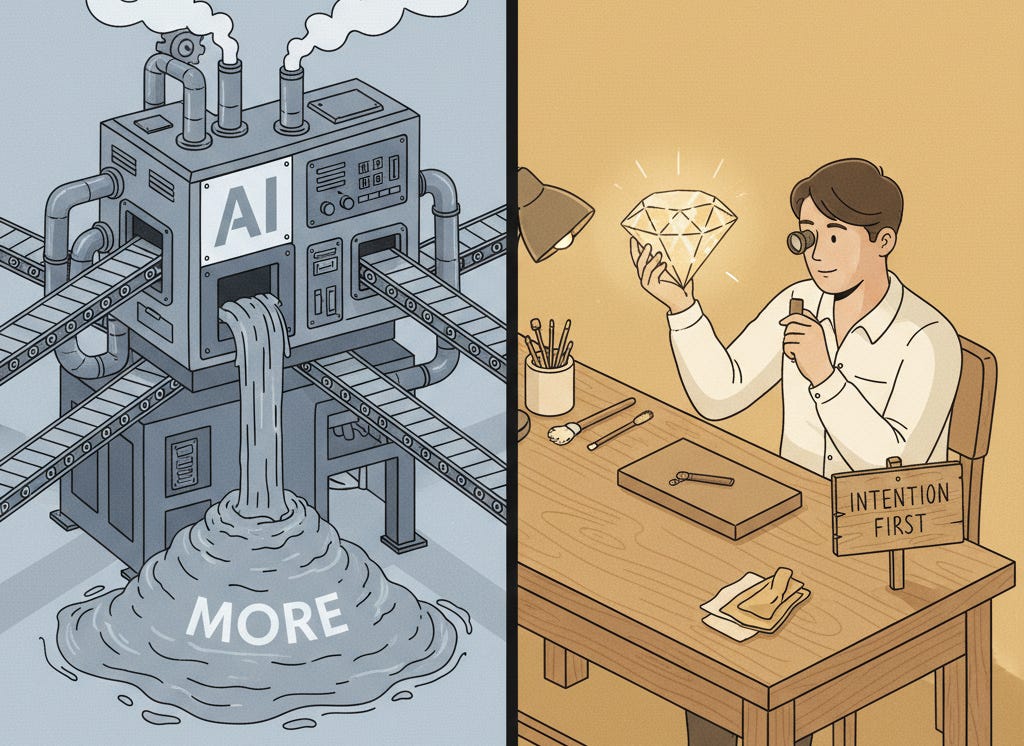Better before bigger: You first, then AI
Use AI to create something great. Then do more. Not the other way around.
The call is deafening: do more. Produce more. Be more.
And AI can do that for you. More is quite easy with AI. A simple prompt can create something new. Wrap that in a workflow and you can flood the zone. Scale is trivial. But quality is not.
It’s not like we haven’t seen this pattern before.
Email/IM/Slack dropped the cost of a message to zero — inboxes filled, signal fell.
Automation scaled unoptimized processes — defects and downtime scaled with them.
Big data let us store everything — we got data swamps and big storage bills.
We’re already seeing it repeat with AI: more content, more code, more agents, more noise.
In the sense that infinite monkeys with typewriters could eventually write Shakespeare, massive unmitigated “more” would likely produce something of consequence. The question is just whether the world drowns in AI slop getting there.
So what’s the solution?
Intention and refinement.
And AI can actually play a helpful role in the second.
Start with intention
If you’re going to do something at all, you need to start with intention. Otherwise you’re just setting off a runaway train.
Intention is what you’re trying to do:
Marketing: What behavior change are you seeking (lead, purchase, activation)? For which segment? Why will this message work on them now?
Code: What capability are you adding? Where does it sit in the architecture? What are the trade-offs (speed, cost, security, failure modes)?
Opinion: What’s the single thesis you want the reader to leave with? What’s the strongest counterargument?
Internal memo: What decision do you need, from whom, by when? What’s essential for that decision—and what’s noise?
Don’t gloss over this, because it’s not as easy as it sounds. It forces you to, yes... think. But when you start with crystal clear intention, you’re giving AI coal rather than mud to work with — and coal is much closer to a diamond than mud.
Then use AI to refine
Next, you can turn to AI. But not to create. To refine.
Use it as a thought partner to help think through that intention. Resist the urge for it to be your expert and have it instead be your own personal Socrates — wisely challenging and pushing you to think more deeply about what you’re doing.
For your marketing message, explore why you expect the messaging to work for that particular audience and conversion type.
For your code, consider how the functionality fits within the overall architecture and how different approaches might have trade-offs in areas like speed, cost, or security.
For your opinion content, push yourself to get really clear on what you’re leaving your reader with. Get beyond writing “about” something to having that clear thesis.
For the work memo, get to that clear intention that separates the necessary from the superfluous.
Use AI to help you explore these areas. Use it to learn about how you’re approaching the task and where you might rethink that approach. Use it to press you and your idea hard — hard enough to turn that bit of coal into a diamond.
To be sure, this isn’t as easy as prompting “Please write a quick memo that shares the information from the report below.” And it can seem slow and even silly to take so much time for one single thing.
But here’s the thing: Create that one diamond and you’ll start to understand the process of making diamonds. Do it again, another diamond. And again. Only then: more.
The predictable consequences
The buzzword today is “AI slop” — and for good reason. Much of what’s being created is blind “more” with no intention and no refinement. If there was a signal-to-noise problem before, it’s only compounded now.
But in the end it all shakes out:
Marketing automation without intention bleeds out in negative-ROI spend.
Codebases built blindly on more code tie themselves up in knots.
Writers who lean on more over quality end up ignored and unread.
Companies that don’t deliberately create a culture of intentional communication find themselves bogged down, slow, and stuck.
The simple formula
If you want to keep it simple, always practice this: You first.
You first, then AI. Your idea, your draft, your intention first. Then bring it to AI.
I’m a strong yes to AI. But AI done well. Done wisely. Done intentionally.
Do that, and you can actually make “more” meaningful.


